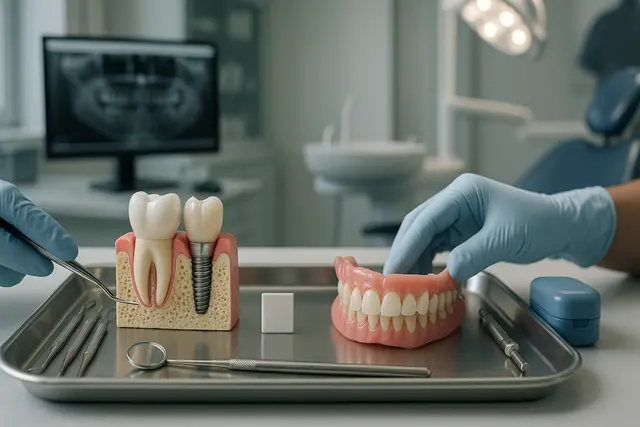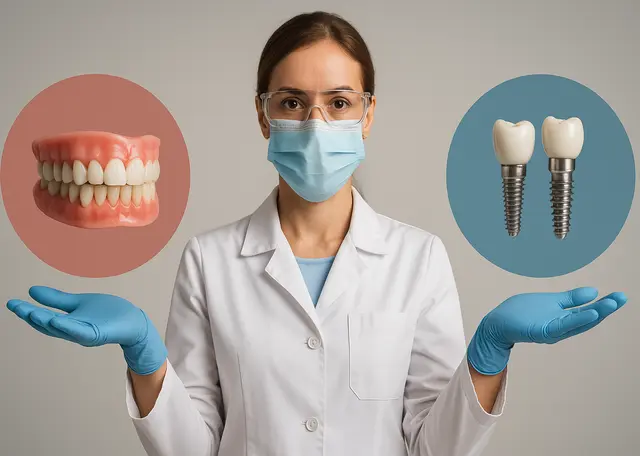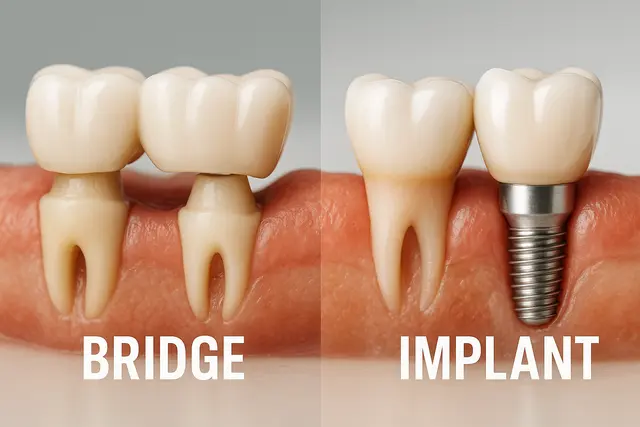Prosthodontics
5 min read
Mar 28, 2025
All-on-4 vs. Traditional Implants: Which Is Right for You?
Tooth loss is more than a cosmetic issue, as it compromises how you chew, speak, and maintain overall oral health. As dental technology has progressed, implants have become the gold standard for long-term tooth replacement, offering an alternative to dentures and bridges. Two leading implant-based solutions are traditional implants and All-on-4 implants. While both restore function and aesthetics, they follow different strategies in design, placement, and cost structure.

When you experience tooth loss, every skipped crunch feels like a tiny defeat. If you’re tired of soft snacks and hiding your grin, a dental implant can restore your smile, protect long-term oral health, and help you bite with the confidence of natural teeth.
In modern dentistry two players dominate the conversation: the classic traditional dental implant and the speedy all-on-4® implants. Both are dental implants, artificial tooth roots that fuse with jawbone, but their timelines, costs, and bone demands differ enough to sway your choice.
Dental Implant Basics
A dental implant is a small titanium post set deep into the jawbone. Implants are surgically placed, then left to heal while osseointegration to take place, the metal and bone knit together, creating a rock-solid base.
Once that happens, a porcelain crown or bridge clicks on. Implants are artificial tooth replacements, but they look and feel like natural teeth and keep bone from shrinking. Because implants are both used for single-tooth repairs and full-arch makeovers, they’re a great, permanent fix that outperforms traditional dentures in stability and chewing power.
Traditional Dental Implant Treatment
Think of traditional dental implant surgery as a marathon. Your dentist places one implant per missing tooth, waits months for healing, then adds the final crown. Traditional dental implants require solid bone, so a bone graft may come first if the ridge is thin. That extra step adds to treatment time, and implants require at least two surgeries, placement and crown, plus several follow-up visits.
Average healing time for dental cases runs four to six months, and posterior implants (those tucked in the back) sometimes need wider screws for heavy chewing. Traditional implants require patience, but they offer a custom crown for every gap and a bite that feels truly personal.
The All-on-4 Dental Implant Method
The all-on-4 dental implant method is the sprinter. Using four dental implants per arch, two straight in front, two angled posterior implants, the surgeon supports a full set of teeth in one go. Because the angled posts grip denser bone, the need for bone grafting drops sharply.
The all-on-4 procedure often lets you leave with a provisional bridge the same day, so dental function returns fast. Four implants per arch mean fewer appointments and lower costs, and since all-on-4 uses fewer implants, the surgery is simpler than traditional full-mouth cases.
Benefits of All-on-4 Implants
The benefits of all-on-4 are easy to love. All-on-4 implants offer one surgery and a bridge that won’t budge when you sneeze. The advantages of all-on-4 implants include fewer implants to support the prosthesis, so you spend less time in the chair compared to traditional dental work.
Dental implants offer serious chewing strength, yet all-on-4 implants provide it faster because the bridge locks in immediately. All-on-4 implants are required per arch, not per tooth, so the number of implants shrinks while stability stays high, good news for the wallet and the nerves.
All-on-4 vs Traditional Implants: Key Differences
Let’s stage a friendly cage match: all-on-4 vs traditional implants. Key differences between all-on-4 and traditional boil down to the number of implants, treatment timeline, and bone requirements. Traditional dental implants may use multiple implants, sometimes eight implants, for a full mouth; all-on-4 relies on just four.
Comparing traditional dental implants to the four-post newcomer shows stark contrasts: traditional implants typically require grafting, longer healing, and more appointments, while all-on-4 and traditional dental implants both deliver fixed, permanent teeth. The difference between all-on-4 and traditional is speed and simplicity, whereas all-on-4 shines for folks eager to eat steak before the next holiday.
Bone Graft, Jawbone, and Healing Time
Your jawbone is the foundation. A bone graft thickens a narrow ridge so implants are placed safely, but implants require a few appointments and months of healing. The need for bone grafting lengthens healing time for dental implants because implants are artificial tooth roots that can’t be loaded until the graft matures.
All-on-4 and traditional dental implants diverge here: the all-on-4 method tilts its posterior implants into dense bone, often skipping the graft. That move can cut the average healing time for dental cases in half, freeing you to chew sooner. Unlike traditional bridges, implants stimulate bone, preserving facial shape.
Denture or Implants? Everyday Dentistry Face-Off
Dentures have served society for centuries, but they can slip when you laugh and provide no bone stimulation. Dental implants to support a bridge clamp down tight; implants vs traditional dentures is really a stability debate, and implants win.
Dental implants and all-on-4 implants change the story for people fed up with adhesive cups. Implants provide the bite force of natural teeth, so you can tackle steak instead of soup. If cost rules out surgery, a traditional denture still restores appearance, but implants are a permanent upgrade in confidence.
Candidate for All-on-4
Wondering if you’re a candidate for all-on-4? If you have multiple missing teeth, controlled medical conditions, and enough front-jawbone depth, you likely qualify. Since all-on-4 uses only four implants per arch, even patients short on bone for traditional implants may fit the bill.
Your dentist will measure jaw density, discuss the number of implants planned, and explain how implants per arch affect comfort and cost. Implants typically require good hygiene and routine checkups, but the payoff lasts decades.
Learn More About All-on-4 and Traditional Dental Implants
Ready to stop worrying about missing teeth? Book a consult to learn more about all-on-4, getting dental implants, and which plan fits your life. We compare dental implants and all-on-4 implants side by side, including dental hygiene tips, digital scans, and every treatment time checkpoint.
Traditional dental implants and all-on-4 dental approaches both excel; the best choice depends on your jawbone, schedule, and budget. Whether you choose four implants, eight implants, or multiple implants across both arches, we’ll map out a route that restores your full set of teeth and puts crunchy apples back on the menu.
What Is the Main Difference Between All-on-4 and Traditional Dental Implants?
The main difference lies in the number of implants and treatment timeline. Traditional implants often require one implant per missing tooth and involve multiple surgeries with longer healing. All-on-4 uses just four implants per arch to support a full set of teeth, often allowing same-day function and reduced need for bone grafts.
Do All-On-4 Implants Require a Bone Graft?
In many cases, no. All-on-4 implants are placed at strategic angles to anchor into dense areas of bone, often eliminating the need for bone grafting. This reduces healing time and makes the procedure possible for patients who lack the bone density needed for traditional implants.
How Long Does It Take to Heal From Traditional vs All-On-4 Implants?
Traditional implants typically require four to six months of healing between placement and the final crown. All-on-4 implants can support a provisional bridge the same day, allowing faster return to function. Full healing still takes a few months, but patients often enjoy immediate cosmetic and functional benefits.
Who Is a Good Candidate for All-On-4 Dental Implants?
Ideal candidates have multiple missing teeth, good overall health, and enough jawbone in the front of the mouth. Even those with bone loss in the back of the jaw may qualify, thanks to the angled placement of the rear implants. Your dentist will evaluate your bone, health history, and treatment goals to determine the best fit.
Read Next
Related Posts

Prosthodontics
Implant vs. Dentures Pros and Cons: A Deep Dive into Modern Solutions
Missing teeth can impact more than just your smile, they can affect how you eat, speak, and feel about yourself. Fortunately, modern dentistry offers two leading solutions to bring back both function and confidence: dentures and dental implants. Understanding the pros and cons of each can help you make the choice that fits your needs, lifestyle, and budget.
7 min read
Oct 17, 2025

Prosthodontics
Full Mouth Implants vs. Dentures: Which Is Better for You?
When it comes to replacing missing teeth, the choice between full mouth dental implants and dentures can be overwhelming. Each option has its own set of benefits, limitations, and long-term considerations, making it essential to understand what works best for your needs, health, and lifestyle.
5 min read
Oct 17, 2025

Prosthodontics
Tooth-Supported Bridge vs. Implant Comparison: Benefits, Drawbacks, and Insights
Deciding between a dental bridge and a dental implant can feel overwhelming, especially when both options promise to restore your smile and improve oral function. Each solution comes with its own set of benefits, considerations, and ideal use cases, making it essential to understand how they compare before choosing what’s right for you.
6 min read
Oct 17, 2025
Don’t have time to research every dentist around you?
See why 30k+ patients trusted us